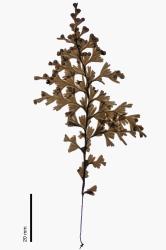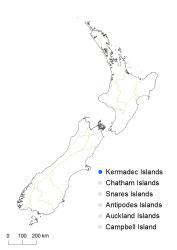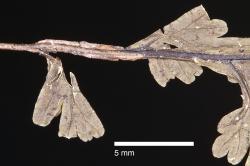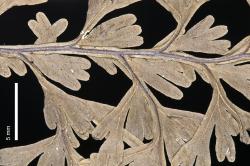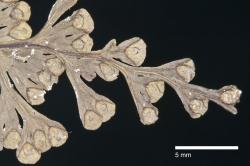- ≡ Trichomanes polyanthos Sw., Prodr. [Swartz] 137 (1788)
Epiphytic ferns. Rhizomes long-creeping, c. 0.3 mm diameter, bearing red-brown hairs up to 0.1 mm long clustered at bases of stipes. Fronds 90–100 mm long. Stipes 20–35 mm long, red-brown, narrowly winged for at least half their length, glabrous or bearing a few scattered hairs at base; stipe wing planate. Laminae 3–4-pinnatifid, elliptic or ovate, 60–80 mm long, 20–50 mm wide, green turning red-brown with age, membranous, glabrous. Rachises winged throughout, red-brown, glabrous; rachis wing planate. Primary pinnae in 10–12 pairs, scarcely overlapping, winged throughout, ovate, adnate; distal portion of primary pinnae straight; the longest primary pinnae at or below the middle, 16–25 mm long, 7–13 mm wide, the proximal primary pinnae sometimes greatly reduced. Secondary pinnae arising both acroscopically and basiscopically, scarcely overlapping, winged throughout, ovate, often divided into two segments of unequal size and dissection, adnate; the longest secondary pinnae 5–8 mm long, 3–5 mm wide. Ultimate lamina segments oblong, up to 2 mm long and 1 mm wide, planate; apices obtuse or truncate or slightly emarginate; margins entire, lacking a distinct border; distal segments on primary pinnae divergent. Sori terminating ultimate segments at the distal ends of the pinnae, solitary on each segment, several on each primary pinna, partially immersed in lamina; indusia bivalvate; indusial flaps elliptic or obovate, 1.5–1.75 mm long, apices obtuse or truncate, margins entire; receptacles included within indusial flaps.
Hymenophyllum polyanthos is similar to H. dilatatum, H. pluviatile and H. australe in having a planate wing extending at least half way down the stipe from the rachis. It can be distinguished from H. pluviatile and H. australe by the sori which are sunk into the lamina segments, rather than being adnate to the segments. It differs from H. dilatatum by the narrower ultimate lamina segments (c. 1 mm rather than 1.5–2 mm wide), the often emarginate rather than acute or obtuse apices, and the shape of the indusia which tend to be obovate rather than orbicular. It is also confined in New Zealand to the Kermadec Islands, unlike the other species which occur on the main islands.
Kermadec Islands.
Altitudinal range: c. 450 m.
Hymenophyllum polyanthos is a rare fern in New Zealand, at the southern limit of its distribution, and known only from Raoul Island, Kermadec Islands.
Also Australia (Queensland), Solomon Islands, Vanuatu, Fiji, Samoa, Cook Islands, Society Islands, Marquesas Islands, Austral Islands and pantropical in the New and Old World.
Recorded growing on Melicytus ramiflorus in wet Metrosideros forest at 450 m on Raoul Island, associated with Hymenophyllum demissum and Plagiochila pacifica.
Hymenophyllum polyanthos was given a conservation status of Naturally Uncommon by de Lange et al. (2013).
Ebihara et al. (2010) noted that H. polyanthos in the Pacific region forms a clade distinct from plants in the Neotropics and East Asia, and that it probably requires a new name.



